Discover our new LED retrofit ranges
The more you can see, the better you perform, the faster you react and the safer you are.
So don’t let darkness win, choose Philips and start driving at night with greater confidence and control.

Got a question?
All you need to know about LED lighting is here!
Got a question? Discover answers from our LED lighting experts.
- What is LED retrofit? For which applications?
-
It’s a solution for the drivers who want to upgrade their lighting solutions to replace their halogen/conventionalbulbs.
In terms of applications, it has to be separated between interior and exterior lights:
- Interior:

- Exterior:

- What is the difference between Vision and X-tremeUltinon range?
-
Two aspects are differentiating these 2 ranges: an enhanced performance for the X-tremeUltinon with state-of-artLED technology and a better lifetime for the X-tremeUltinon.
- How the lifetime of an LED is calculated?
-
Generally speaking, the most critical piece of an LED is the PCB (Printed Circuit Board) because it heats a lot and if not properly cooled down, its performance will decrease.Therefore we always calculate the lifetime of the LED based on this PCB.
- What is the purpose of the control box?
-
It takes the car voltage (12V) and convert it into whatever voltage is required for the LED to run properly - What is generally the first failure point of an LED?
-
First things first, the construction of the LED lamp is critical to maintain its optimal performance over its lifetime. Since heat is a major issue for LED, the system to cool down the LED is a critical part (fan and/or heat sink). The bulb needs to be properly maintained within the headlamp so that it’s not moving and/or damaged while driving. - Why should I buy this product?
-
The advantages of this range are numerous:- You can replace a conventional bulb to get the latest technology in lighting for an affordable cost (no replacement or the full headlamp or no purchase of a new full LED car)
- You will get a better visibility on the road for more safety for you and others drivers
- You will have a stylish white lighting to give a refreshed look to your car and match DRL on your car
- You will benefit from a higher lifetime, meaning cost saving of replacing conventional bulbs every 1-3 years
- Are Philips LED range environment friendly?
-
Yes, Philips LED range contributes to environment protection by:1. Significant energy saving, consuming less overall resources and emitting less CO₂
2. Fully compliant with RoHS / REACH, which means no hazardous materials which are harmful to the environment
3. Long service lifetime which means elimination of unnecessary replacement related waste and system costs, while reducing overall resource consumption.
- Can I save money by switching to LED?
-
Yes, Philips LED has a an extended lifetime, which means you save the cost and hassle of frequent bulb replacements which on average occur every 1-3 years. In addition, a LED bulb uses substantially less energy (e.g. halogen H4 consumes 55W where an H4 LED drawn 23W). - How would I recognize a fake Philips/Lumileds bulbs from a genuine?
-
Whenever you purchase a Philips LED retrofit for your headlights, you can check the authenticity online using the code provided on the anti-fake label. This is an insurance for you that you get a genuine Philips LED. - How do I know if the LED retrofit is compatible with my headlamp?
-
To check the compatibility of the LED Retrofit with your car,1. Measure the diameter of your headlamp and the space that you have behind the headlight fixture. To be able to install the LED retrofit you need minimum 60mm diameter and 70mm back space behind the fixture.
2. Check if the connector is also used as a bulb holder. If it is the case, you won’t be able to mount the LED Retrofit. If you have any doubt, please check with your dealer/installer.
- Is there a warranty on our LED range?
-
We apply a 3 years warranty for our Ultinon LED range and a 5 years warranty for the X-tremeUltinon. - What are the advantages of the Philips LED design?
-
The Philips LED design is patented. The construction of the Philips LED bulb is unique are gives a lot of advantages:1. It’s optimized to ensure the benefits in terms of performance and lifetime
2. The beam pattern is perfectly adjusted to distribute the light where needed upfront
3. The position of the LEDs (chips) are exactly placed like on a conventional bulb reproducing perfectly the same light distribution
4. Its gives to the LEDs extra robustness: shock-resistant, moisture proof and resistance to voltage surges.
- What does CANbus stand for?
-
It stands for Control Area Network Bus, and it monitors your vehicle’s conditions during operations. Most of the newest European models are equipped with CANbus, therefore Philips strongly advice to check with your dealer what’s the system within your car prior to purchases. - What are the meaning of “AirFlux”, “CeraLight” and “SafeBeam”?
-
- Safebeam: Projects light exactly where you need it for your safety (no glare for oncoming racers). The Figure Of Merit (FOM => light projected on the road) is in concordance with ECE R112.
- Airflux: the latest thermal management with active (H7) and passive cooling (H4) systems for increased lifetime and performance. We uses passive cooling when the spacing within the headlamp is big enough to effectively dissipate the heat without the risk of decreased performance. On H7 headlamp, the optic is generally smaller than H4, so the heat dissipation needs to be active to effectively direct the hot air away from the back of the LED.
- CeraLight (Specific to T10 XU): using ceramic components for best heat dissipation management to ensure highest durability in extreme conditions.
- Why the LED-4 got a heat sink and the LED-7 got a fan?
-
Initially, the construction of a headlamp for a halogen H4 and H7 is different.The first one, the halogen H4 is commonly fitted on headlamp who are larger in size (to cover both low beam and high beam function). Therefore, the space within the headlamp is enough to efficiently dissipate the heat away from the lamp.
The headlamp for an H7 is small in size, and due to that, the use of fan is necessarily to circulate the hot air faster.
- How can I verify which LED to use to replace my old bulb?
-
Simply use the section “Find the right lamp for your car” on the Philips website to find out which lamp type you need. Each type is communicated with the corresponding ECE name. Here below the comparison table between halogen and LED retrofit: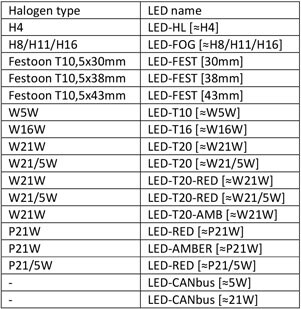
- Is it better to use a Xenon HID conversion kit or an LED Retrofit?
-
To upgrade your halogen car into a Xenon car, you need to change the full headlamp, meaning a heavy & costy transformation of your car. Using an LED Retrofit, you will be able to only replace the bulb while keeping your existing headlamp. Even though the performance of a Xenon conversion kit is higher than for the LED, the total maintenance cost remains in favor of the LED retrofit. - Is it mandatory to use a CANbus adapter while fitting LED?
-
It’s strongly recommended to use a CANbus adapter to avoid either an excessive speed of the blinking or an error message on the dashboard. - What SMD or SMT means?
-
It means a Single Mounted Device and Surface Mounted Technology. It refers to how the LED lamps is built and how the LED are used to diffuse the light within the optic.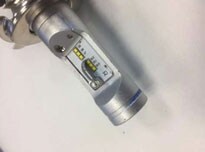
- Why most of the competitors are using Lumileds chips?
-
They are today the best performance chips you can find on the market in terms of performance and durability. On top of it, they are today the smallest chips you can get: 16x20mm instead of general 35x35mm or even 50x50mm which was for a long time the automotive standard. Thanks to this size, they can almost perfectly match the shape and positioning of the filament of the halogen bulb they replace. - Binning of the LED chips. How do we chose them to make sure that we have the same CCT for each PCB?
-
As a manufacturer of LEDs, we have the knowledge when it comes to the best LED chips possible. All the LEDs selected to produce our lamps have the exact same color temperature, which means that whenever you purchase one of them, you’re sure that you get the best light output and homogeneity. - Why Philips LED don’t have integrated CANbus?
-
At Philips, we chose to have separated CANbus for 2 reasons:1. Most of the time the CANbus is not necessary to install
2. When needed, it’s better to have it separated than integrated because if integrated inside the bulb it makes the lamp bigger and too expensive. Except for the blinkers where the CANbus is mandatory (automatically sold with CANbus in the box) so that the blinking is at the right pace, in most cases it’s not required to fit one. Here below the applications where a CANbus could be/is necessary:
- Turn indicators (front and rear)
- Headlighting (low beam / high beam and Fog)
- Position light
- Is the 24V festoon equipped with CANbus?
-
They are no CANbus with the 24V festoon, because it’s not needed on all the vehicles. If a CANbus is needed to avoid error message or blinking, please use the Philips 21W CANbus. - Is it possible to use the 21W CANbus for 24V LEDs? If yes, how many per lamps is required?
-
Whether it’s Philips CANbus 5W or 21W, they are not specifically dedicated for one reference. Their purpose is to increase the wattage of the LED so that it avoids having error message at the front, avoid flashing when the LED turns on and prevent the turn indicators to blink faster than they should. - Does the CANbus removes the residual current at the time when the lamp goes off?
-
The Philips CANbus are designed to regular the amount of wattage withing the electrical system before it reaches the LED. When the LED is off, the remaining power is drawn by the CANbus. So that the LED stays off. - Does the progressive on/off of exterior lamps on certain vehicles remain after installing LEDs?
-
Philips LED retrofit range has been designed to perfectly replace the current light setup that is in the car. This meaning that the progressive shutting on or off functions will continue to function after LED installation. - How does the beam geometry fit in comparison with a normal H4/H8/H11?
-
Each LED within the Philips range has been designed based on halogen/conventional bulb, following the specification of each certification to ensure a reliable product for the drivers and for the others while driving. The geometry of the headlighting follows scrupulously the one they are replacing. - On the driver box of the LED lamp it says: “Caution: Do not touch – Hot surface”. How hot will this become? Is it getting this hot that it can damage cables or any other car parts under the hood?
-
Philips strongly recommend that the driver box is always safely attached with the plastic strips to avoid to move while driving and that the box is attached on a metal part in case it gets hot. - After installing an LED light, would I get an error message on the dashboard?
-
The LEDs have a wattage (lower power consumption) than conventional lights. Some cars are equipped with light detection system to warn the driver that one of the light has failed. Meaning the system sends electric impulses in the electrical system to verify the functioning of lights. Hence when the systems checks, the power emissions are too low to be detected. In such cases, Philips has developed in his range a CANbus system which convert the power and avoids any error message.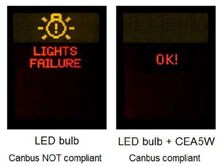
- What happens if the blinkers fail?
-
If the blinkers fail but not the CANbus, the blinking will still be normal (the CANbus will still drawns enough energy for the blinking) but the LED won’t work anymore. In this case a visual check is necessary to detect if the lamp is still functioning. - How do I replace the incandescent bulb with a LED bulb? Is it difficult?
-
The entire Philips LED range is a retrofit of halogen and conventional bulb, making it easy to replace. Just need to follow the guidance on or in the package, and making sure prior to purchase that your optic is suitable for LED in terms of spacing. - The LED does not light up after installation. How can I resolve this issue?
-
If your LED doesn't light up, it’s likely that you need to "reverse the polarity" by flipping the LED. LED bulbs work like batteries with a positive and negative polarity. In case the LED does not light up, simply remove the LED, flip direction and reinstall as per explanation and illustration below:
1. Remove the LED from the socket2. Flip the LED
3. Insert LED back into the socket.
4. Check to ensure the LED lights up
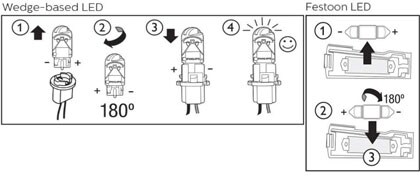
- Which CANbus adapter do I need: 5W or 21W?
-
The 5W CAN-bus is used for interior applications, and license plate lighting. The 21W CANbus adapter is used for exterior applications such as position light, low/high beam lights. Always refers to the original wattage of the halogen/conventional lamp. As an example, a P21W usually drawn 21W, when our LED-RED [≈P21W] has a wattage of 1.9W. The gap is then 21W-1.9W = 19.1W. This means that to compensate this gap of wattage, you should use a Philips 21W CANbus. - How do I install an LED CANbus adapter?
-
If your car has a dashboard error message, experiences fast flash or goes in limp mode upon installation of an LED bulb, you may consider to purchase and install a Philips CANbus adapter solution. See below image for installation instructions for the CANbus adapter: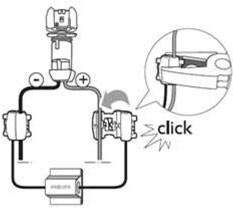
- Why does this polarity issue occur with LED?
-
Regular incandescent bulbs can draw current in either direction, there are no "positive" or "negative" sides on the bulb. The bulb will work regardless of which direction it is inserted. LED bulbs, however, only draw current in one direction. Basically, this situation can be compared to batteries that have a positive and negative side. So if the LEDs are inserted incorrectly, they will not work. The solution is to simply flip the LED. - After installation of the LED, my car show fast flash errors as if my light is out or broken?
-
Error messages appear because the LED bulb wattage is much lower than conventional bulbs, which can make an outage warning system unable to detect the bulb. If your car shows fast flash upon installation of an LED bulb, you may consider to purchase and install a Philips CAN-bus adapter solution. - After installation of the LED, my car does not start. What should I do?
-
After installation of LED bulbs, some cars go in limp mode. The LED has a different resistor value than an incandescent bulb, so the car’s computer is looking for the resistor value of the incandescent bulb. That is the reason why the car goes in limp mode after installing the LED: it notifies the driver that something is not working. Thankfully this happens rarely and the issue can be resolved. First verify that the limp mode is being caused by the LEDs by replacing them again with the incandescent bulbs. If the car works fine, the limp mode was most likely caused by the LED bulbs. This means that a load resistor, a CAN-bus, is required. - When installing an LED for turn indicators, is the blinking rhythm remains the same as for conventional or it becomes faster?
-
In each boxes of our turn indicators we provide two CANbus that are necessary to install to ensure that the blinking of the LED remains at the same speed as the conventional lamp. If not installed, the LED blinking will be faster as if one of the bulb is broken.
Remember: always safely attached the CANbus adapter on a metal to avoid movement and damages for your vehicle. - What are the legal risks if I drive with my vehicle equipped with LED on the road?
-
The risks vary from one country to another, but in general there is a risk of losing your driver’s license and car insurance, as well as legal penalties. - Why is it dedicated for rally and race track?
-
With the exception of cars which are already fitted with LED by the car manufacturer, it is not allowed and not ECE certified to replaced halogen bulbs by LED because the lamp “housing” hasn’t been manufactured for this purposes, hence not reflecting perfectly the light on the road where its required to be certified. - Will it pass the MOT?
-
The Philips LED range has been designed to best replace the original conventional technology on the car without any modifications of the vehicles. Despite performance and technical aspects following ECE certification, since this is not the original technology, and it’s only designed for off-road purposes, you shouldn’t have to pass the MOT. - What is the reason why led is still not legal for broad usage in all roads?
-
Philips LED retrofit range has been designed to replace halogen/conventional technologies within optics that have been certified following these halogen/conventional certification. Today, they are no certification that can be applied to LED retrofit, hence making it not legal for road usage. - What is the specific regulation that LED must fulfill?
-
Today the retrofit of halogen with LED has no ECE certification. ECE Certifications that exist today are only for lamp (halogen, xenon, LED) where the optic has been developed according to it:- ECE R37 for halogen
- ECE R99 for Xenon
- ECE R128 for LED
- What is the impact of R128, and why Philips LED doesn´t fulfill?
-
ECE R128 is the certification of LED optics, meaning that the headlamp has been developed taking into account that the light source will be of LED. Hence it doesn’t apply to LED retrofit which are used to replace halogen lamps certified under ECE R37. - Legal consequence for customer to sell LED
-
Depending on which country within EMEA, legal sanctions could be as below:- Monetary sanctions
- Recall & sales stop
- Other sanctions like suspension business or criminal sanctions
- When a consumer is detected with LED on road, who is the responsible for this foul, customer or distributor/store?
-
In countries where the of-road exemptions is in place, the sole consumer is responsible for the use of LED retrofit on the road, because he’s been warned by Lumileds and its partners with a clear disclaimer of the potential risks. - How to prove that a LED is legal (other suppliers are offering led telling that is legal?)
-
They are no retrofit products today that are legal in Europe, unless the lamps developed is sealed in the optic and that the combination of the retrofit solution and the optic have been both validated. That means that for each vehicle on the road, a full test needs to be performed to be certified (e.g. Osram with Golf VII LED optics). This ECE certification is R48.

It is your own responsibility to ensure that the use of the LED retrofit lights complies with applicable local legal requirements.




